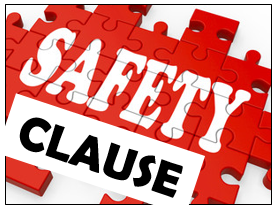by Conrad Imel and Pierce Lively
You might be familiar with the “safety clause” that is included at the end of some bills, but that clause now looks a little different. To better reflect the language in the Colorado Constitution, for all bills going forward the safety clause will be:
“The general assembly finds, determines, and declares that this act is necessary for the immediate preservation of the public peace, health, or safety or for appropriations for the support and maintenance of the departments of the state and state institutions.” (New language in bold.)
In this article, we will explain a little background about the safety clause and why the Office of Legislative Legal Services decided to make this technical change.
The language of the safety clause derives from the stated exception to the referendum power described in article V, section 1 of the Colorado Constitution. At the general election held in 1910, Colorado voters adopted an amendment to the constitution to give the people the authority to make laws through the powers of initiative and referendum (for more information about both the initiative and referendum powers, check out this LegiSource article). The referendum power as set forth in article V, section 1 (3) reads as follows:
“(3) The second power hereby reserved is the referendum, and it may be ordered, except as to laws necessary for the immediate preservation of the public peace, health, or safety, and appropriations for the support and maintenance of the departments of state and state institutions, against any act or item, section, or part of any act of the general assembly, either by a petition signed by registered electors in an amount equal to at least five percent of the total number of votes cast for all candidates for the office of the secretary of state at the previous general election or by the general assembly. [. . .].”
What this means is that the people of Colorado may rescind all or part of an act passed by the General Assembly. By collecting and submitting signatures to the Secretary of State, an individual may place all or part of an act on the ballot for voter approval or disapproval. There is an exception, however, to this power: if the act is necessary 1) for the immediate preservation of the public peace, health, or safety; or 2) for appropriations to support a state agency or institution. The General Assembly invokes the exception by including a “safety clause” at the end of the act.
The very first bill enacted with a safety clause, House Bill 348 adopted in 1913, referenced both types of laws excepted from the referendum power: “In the opinion of the General Assembly this act is necessary for the support and maintenance of the department of State and state institutions and it is hereby declared to be necessary for the immediate preservation of the public peace, health and safety.” Initially, the General Assembly used inconsistent safety clause language, but for the past 75 years or so, the safety clause has only included the language related to the act being necessary for the immediate preservation of the public peace, health, or safety.
 Which brings us to today. Prompted by discussions among Office of Legislative Legal Services staff, the Joint Budget Committee and Joint Budget Committee staff, the Office of Legislative Legal Services has decided to update the safety clause to reflect both types of acts excepted from the referendum power: preservation of the public peace, health, or safety, or appropriations to support a state agency or institution. This change does not alter the standard for when a safety clause may be included on a bill; it merely makes the safety clause better reflect the language in the constitution. It remains within the General Assembly’s discretion to invoke an exception to the referendum power by including a safety clause.
Which brings us to today. Prompted by discussions among Office of Legislative Legal Services staff, the Joint Budget Committee and Joint Budget Committee staff, the Office of Legislative Legal Services has decided to update the safety clause to reflect both types of acts excepted from the referendum power: preservation of the public peace, health, or safety, or appropriations to support a state agency or institution. This change does not alter the standard for when a safety clause may be included on a bill; it merely makes the safety clause better reflect the language in the constitution. It remains within the General Assembly’s discretion to invoke an exception to the referendum power by including a safety clause.
Office of Legislative Legal Services staff has updated existing bill drafts that include a safety clause, including interim committee bill drafts, with the updated language. We hope this article helps legislators and the public understand the updated safety clause that they’ll start seeing on bills.

